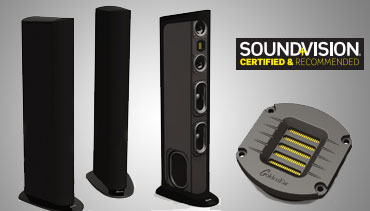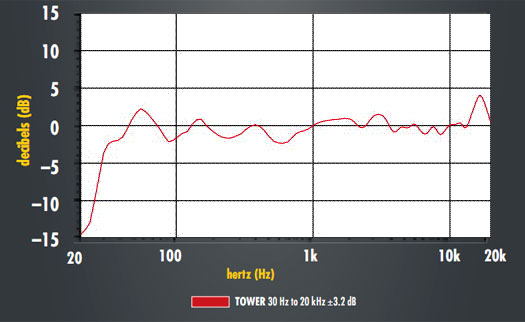Test Report: GoldenEar Technology Triton Two Tower Speakers Page 4


EXTENDED TEST BENCH
Frequency response (at 2 meters)30 Hz to 20 kHz ±3.2 dB
Sensitivity (SPL at 1 meter with 2.8 volts of pink-noise input)
90 dB
Impedance (minimum/nominal)
2.9/5 ohms
Bass output (CEA-2010 standard) Ultra-low bass (20-31.5 Hz): 82.5 d
B Low bass (40-63 Hz): 87.7 dB
The frequency-response curves shown in the graph are weighted to reflect how sound arrives at a listener's ears with normal speaker placement, using an average of curves taken across a horizontal listening window of ±30 degrees and smoothed to 1/12th octave. Measurements were made at 2 meters to ensure that full effects of cabinet diffraction and front-panel reflections were included. All measurements were made with the grilles in place. The Triton Two was measured standing on the ground, which is the way it will always be used. These tests gave quasi-anechoic results down to about 250 Hz. Response of woofers and passive radiators was close-miked, summed, and spliced to the quasi-anechoic response.
The Triton Two's frequency-response measurement looks very smooth. There's a modest dip at 225 Hz (probably at the crossover between the subwoofer section and the midrange drivers), a peak at 375 Hz adjacent to a dip at 560 Hz (probably a result of floor bounce), and a strong peak at 16.6 kHz (probably inaudible to most adult males and many females). Off-axis response is some of the best I've seen-at 45° off-axis, response is almost identical to the on-axis response, with a very mild and consistent treble rolloff. Even at 60° there are barely any off-axis anomalies. It's interesting that we saw similarly excellent off-axis characteristics in the MartinLogan Motion series, another recent speaker line with folded-ribbon tweeters.
Sensitivity of the Triton Two is very good at 90 dB. Impedance runs a little low, hitting a minimum of 2.9 ohms at 3 kHz and averaging about 5 ohms. Maximum impedance phase shift is -46° at 20 kHz-not an extreme shift, and not at a frequency where there's a lot of energy anyway. A bottom-of-the-line receiver might have problems driving the Triton Two to maximum output, but any halfway decent receiver or amp can handle this load.
The Triton Two's bass output is very deep, extending all the way down to 20 Hz, but only moderately loud. Measured by the CEA-2010 standard, average low bass (40-63 Hz) output is 87.7 dB and average ultra-low bass (20-31.5 Hz) output is 82.5 dB. The output is limited not by distortion but by other factors. At frequencies of 31.5 Hz and below, a limiter kicks in to protect the drivers before the speaker reaches the CEA-2010 distortion thresholds. At frequencies of 40 Hz and above, mechanical noises can be heard from the woofers before the distortion measurement thresholds are reached. - Brent Butterwort












































